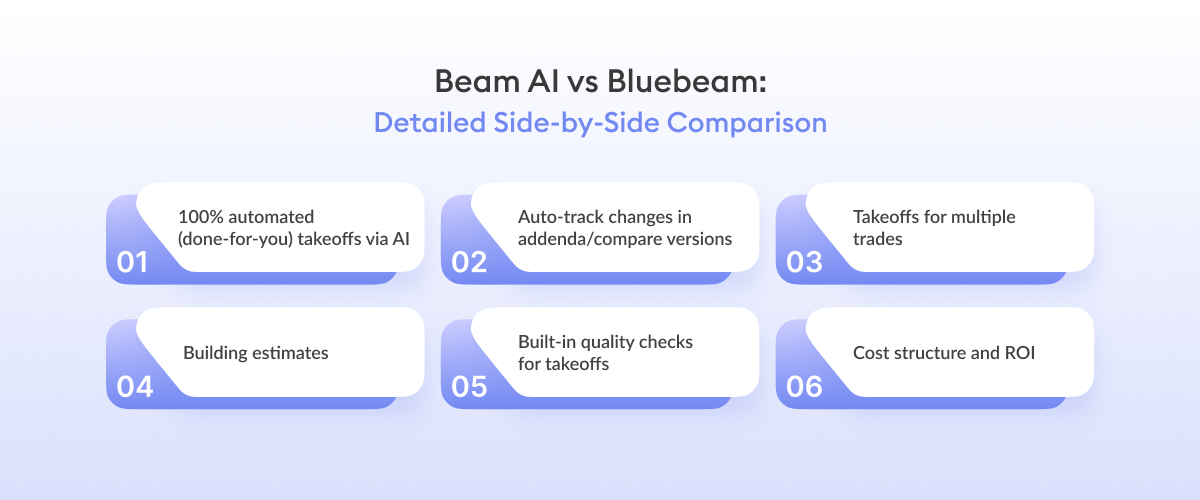For contractors and suppliers, choosing the right construction takeoff software is a critical decision that impacts bid volume, accuracy, and profitability. For years, Bluebeam Revu has been a staple for construction pros, but the emergence of AI-based takeoff software like Beam AI offers a new scope, challenging the traditional method. This comparison dives deep into Beam AI vs Bluebeam to help you determine which digital quantity takeoff tool is best suited for your business needs.
Understanding Beam AI vs Bluebeam: An Overview
If you’ve ever found yourself halfway through bid week wondering where all your hours disappeared, you’re not alone. Between calibrating scales, counting fixtures, and handling last-minute addenda, most of your estimating time goes into manual takeoff work—not the strategic parts of bidding that actually win projects.
That’s exactly where Beam AI changes the equation.
Instead of clicking through drawings for days, you simply upload your PDF plans, define the scope of work, and Beam AI handles the rest. Its AI engine automatically identifies and quantifies every relevant element across trades-whether it’s concrete, MEP, or steel.
In short, you’re no longer spending your week tracing lines—you’re spending it pricing smarter, managing more bids, and focusing on project strategy.
According to the Pilkington Construction, their estimating team used to spend three to four days per project doing manual takeoffs in Bluebeam and OST. After switching to Beam AI, they saved a full week per project and were able to bid on 1.5× more jobs without adding staff.
Now, if you’re the kind of estimator who likes to trace every inch of the drawing, Bluebeam Revu is likely already in your toolkit. It’s a manual PDF markup and measurement tool that’s been an industry standard for over a decade, used by contractors, architects, and engineers worldwide.
You manually measure, annotate, and organize takeoffs—letting you spend your day completing the takeoff before you start inputting the data into your estimate templates. Bluebeam’s measurement tools (Area, Length, Count) and Quantity Link feature let you stream your data directly into Excel for further estimating.
Beam AI vs Bluebeam: Detailed Side-by-Side Comparison

The real difference between these two platforms lies in their approach to core takeoff tasks.
When your bid week comes around, a lot of your time as an estimator is spent on one of two workflows: tracing and counting every length, area, and fixture in PDFs, calibrating scales, working around addenda, or handing off a file, and receiving back plug-and-play material quantities: the takeoff is already done, you just price it. The choice of tool often determines which workflow you adopt. Here is a complete breakdown of Beam AI vs Bluebeam to determine which best suits your requirements.
1. 100% automated (done-for-you) takeoffs via AI
When you use Beam AI, you don’t spend hours tracing walls, fixtures, or rebar - you simply upload your PDF plans, select the trades or scopes, and let the platform handle the rest.
Brady Roofing, one of the Beam AI customers, reported saving 5-10 hours per takeoff while increasing bid volume by 40%. This helped them generate an additional $400k in revenue. Now, this is how Beam AI helps you shift your hours to focus on business growth and drive more bidding opportunities.
Bluebeam Revu (Manual + assisted):
Bluebeam does not automatically generate finished, QA-checked takeoffs for you. Instead, it gives you a powerful PDF environment and measurement tools so you can create the takeoff manually inside Revu. That means full control — but the manual work remains. Bluebeam, however, offers features (legends, tool sets, dynamic fill) that speed manual measurement.
2. Auto-track changes in addenda/compare versions
On average, contractors receive two to three addenda for each project they bid on.
When addenda or revisions arrive, Beam AI automatically detects every change so instead of manually rechecking material quantities, the software redoes your entire takeoff, aligning the latest drawings with your previously submitted plan. You can easily view the changes and how it impacted your material quantities and added scope.
Beam AI provides a variance report, which is designed to highlight what values have changed between two versions of a selected takeoff, enabling you to modify proposals better. These changes can be viewed on the Beam AI software and are also available on Excel, which you can export. With this report, you can easily identify every added or deleted quantity without having to flip between plan versions.
This way, you can easily replace the modified quantities from your estimate without having to start from scratch or even scramble to find what has changed.
On the other hand, Bluebeam provides document comparison tools. Overlay Pages and Compare Documents, and in Revu 21/21.1 added Auto Align to make overlays and compare workflows more accurate and faster. Those tools let you visually identify changed geometry; you then adjust takeoffs in your toolset. So Bluebeam automates alignment/comparison, but the measurement/counting remains estimator-driven.
3. Takeoffs for multiple trades
If you’re estimating across multiple trades (say, concrete, structural steel, HVAC, finishes), you’ll appreciate a platform that handles all of them in one shot. Beam AI does the takeoff across multiple trades, so you can upload an entire drawing set—civil, structural, architectural, and MEP—and Beam will automatically break out quantities by trade. You get structured, ready-to-use reports for each scope without lifting a pen tool.
According to G2 reviews, estimators appreciate how Beam AI helps them handle 4-5 times more bids in the same week, with consistent accuracy across all trades. So instead of hopping between tools or calibrating scales repeatedly, you’re reviewing completed takeoffs and focusing on pricing strategy.
Bluebeam, on the other hand, gives you full control-but also full responsibility. It doesn’t restrict you to certain trades, but it doesn’t automate the workflow either. You’ll use the same measurement tools for all trades-length, area, volume, and counts, and then categorize or color-code your markups manually.
Many estimators on Reddit say Bluebeam Revu’s flexibility is a major plus, especially when they need to customize markups for niche scopes or apply trade-specific legends. However, that flexibility comes with a time cost: setting up markups, creating custom toolsets, and cleaning up overlapping takeoffs all fall on you.
4. Building estimates
If you’ve ever lost hours reformatting takeoff data from a takeoff software just to make it fit into your pricing model, Beam AI feels refreshing. Once the AI and QA team finish processing your plans, you get structured deliverables in multiple formats.
For instance, you can download Excel files to add your pricing or labor rates, or access PDF files and a live takeoff link to include in your bid package. No messy exports, no recalibrating columns or rechecking scale factors.
Estimators using Beam AI often say this is where the real time savings show up. You’re not just getting quantities; you’re getting bid-ready exportable takeoffs.
With Bluebeam, the output is as clean as the workflow you build. You do the measurements, organize markups with custom legends and toolsets, and then export using Quantity Link or CSV/Excel export. It’s not automatic - but if you’ve invested significant time in setup, your exports flow directly into your estimating model with little adjustment.
You stay in control of every measurement, every label, every color code. If you already have a detailed Excel pricing model you swear by, Bluebeam fits right in. It’s also great if your team collaborates on measurements and needs to verify quantities visually on the PDFs before costing.
5. Built-in quality checks for takeoffs
Let’s be honest, when you hand off measurement to any software, you want to know if the output is accurate. Beam AI understands that, which is why they built a human QA layer into every takeoff. The AI does the heavy lifting, reading drawings, identifying walls, doors, slabs, rebar, conduits, and then the QA team reviews every output before it ever hits your inbox. The software guarantees ±1% of your in-house takeoff accuracy while giving you the benefit of massive time savings and helping you boost bid volume by 2X.
So even if you spend 15 minutes reviewing Beam AI’s output, that’s nothing compared to your current workflow. Think about that for a second -if you normally spend two full days manually tracing takeoffs in Bluebeam or OST, that’s nearly a day and a half you’d get back. That time can go into reviewing scope gaps, sharpening your pricing, or even chasing more work.
Bluebeam, on the other hand, is all about control and craftsmanship. You’re the quality gatekeeper. You set up the scales, define measurement tools, apply layers, and manage revisions. When you’re up to date, Bluebeam delivers exceptional accuracy. But when timelines are tight or multiple addenda hit your inbox late, human error can sneak in. It does not have a QA level process to double-check every takeoff manually.
6. Cost structure and ROI
Beam AI's pricing model is usage-based, per sheet or per project bundle. The big ROI driver is: "How many extra bids can you do because you freed up estimator hours?" If you save days per job, that’s your metric.
The time it will take you to hire and train a new estimator, set up the software, and manually complete the takeoff is immense. Multiply that by the number of jobs you do per year, and you’ll see real ROI.
Also, if you’re now limited to say 3 bids/week because of takeoff bottlenecks, and with Beam AI you can do 5 bids/week with the same team, the incremental revenue from the extra bids is part of your ROI.
Learn more about the Beam AI pricing model
With Bluebeam, you’re working on a per-user licensing model, which means your costs scale with the number of estimators or project managers using the software. Unlike Beam AI, it does not give you the advantage of adding unlimited users; hence, the value is tied to how efficiently your team uses it. The software doesn’t save you time automatically — you have to put in the effort to build custom toolsets, create standardized markups, and establish a consistent workflow.
Read more about Beam AI vs Bluebeam comparison
Advantages of Beam AI and Bluebeam
Beam AI
- Massive time savings
When your team isn’t buried in manual measurements, they can take on more bids without stretching themselves thin. That directly translates into maximized pipeline and ultimately increased revenue potential. Because Beam automates measurements across entire plan sets, your estimators don’t spend hours clicking lines or counting symbols.
- Supports multiple trades
If you’re an estimator who juggles concrete, structural, finishes, and MEP, you know how tedious it is to run separate takeoffs for each scope. Beam AI’s all-in-one workflow means you can upload an entire drawing set and get trade-specific quantity outputs: concrete, rebar, ductwork, all separated automatically.
- More projects without hitting headcount
For teams already maxed out, maybe you’ve hit the point where every estimator is running 12-hour days just to keep up with bid volume. Beam AI becomes less of a tech upgrade and more of a capacity multiplier. By offloading measurement, you effectively add bandwidth without hiring more staff. The ROI shows up not just in hours saved, but in the number of bids you can now chase and the opportunities you no longer have to turn down.
Bluebeam
- Full Control across takeoffs
If you’re the kind of estimator who likes to see and verify every measurement, Bluebeam gives you that precision. You’re responsible for scale calibration, measurement logic, and markup consistency.
- Collaboration That Scales with Your Team
Bluebeam Revu’s collaboration layer (via Studio Projects and Sessions) is a huge ROI driver for larger estimating teams. When multiple estimators, engineers, or PMs are reviewing the same set of drawings, everyone can markup, comment, and track changes in real time - no duplicate files or version mix-ups.
Final thoughts
Both Beam AI and Bluebeam Revu were built with estimators in mind, but for different eras of preconstruction. Bluebeam remains a benchmark for precision, collaboration, and manual craftsmanship. It’s the digital ruler that defined an entire generation of takeoff workflows.
Beam AI, on the other hand, was built for scale. It’s for teams ready to move from tracing to tracking outcomes, from counting lines to counting more bids. With full-automation, human-verified accuracy, and multi-trade coverage, Beam AI gives you the power to focus on pricing strategy, vendor relationships, and growth, not just measurements.
So if you’re ready to reclaim time, multiply bid capacity, and let AI handle the heavy lifting, Beam AI takes you further, without losing quality.
See how automation can double your bid output and redefine your takeoff process. Book a demo with Beam AI today.
Note: The details presented in this blog regarding Bluebeam are accurate and based on publicly available information from Bluebeam’s official website as of 30th October, 2025.



.png)





.png)


.webp)

